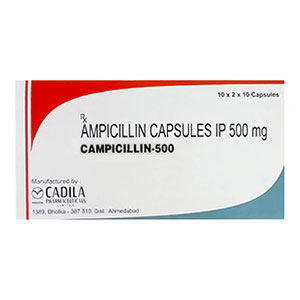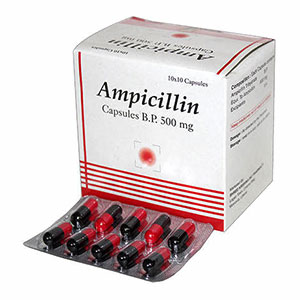The largest price comparison for medicines: the most popular pharmacies in comparison. Buy more than 200 medicines at low prices






Patent: Patent expired
Producer: Ratiopharm GmbH
Dosage: 250mg, 500mg, 1000mg
Dosage form: film-coated tablet(s)
Unit of measurement: mg
Active ingredient: ampicillin
Application areas:
bacterial infections
Drug class:
Onset of action:
Duration of action:

Bioavailability: 0-50%
ATC-Code: J01CA01
Protein binding: ≥ 10%
Metabolism: No data available
Metabolites:
Half-life: 1 hour
Excretion: No data available
CAS number: 69-53-4
PubChem-CID: 6249
Drug Bank: DB00415
ChemSpider: 6013
UNII: 7C782967RD
KEGG: D00204
ChEBI: CHEBI:28971
ChEMBL: ChEMBL174
ECHA-InfoCard: 100.000.645
Formula: C16H19N3O4S
Molar mass: 349,41 g·mol−1
Ampicillin belongs to bactericidal antibiotics that lead to the death of pathogenic microorganisms. Ampicillin has an antimicrobial effect, which blocks the last phase of the formation of the cell wall of bacteria. It binds to the penicillin-binding proteins present in the bacterial cell wall.
This drug does not kill the bacteria directly, but interferes with their division and multiplication.
Ampicillin is a broad spectrum antibiotic that kills a variety of different types of bacteria.
The tablets are taken orally regardless of the meal. The dosage is determined individually by the doctor depending on the severity of the infection, its localization and sensitivity of the pathogen.
When taken orally, a single dose for adults and adolescents is 250-500 mg. It is taken every 6 hours. The total daily dose of 14 g should not be exceeded.
For children, the drug is prescribed in the daily dose of 50-100 mg / kg body weight spread throughout the day with intervals of 6 hours. The recommended daily dose for children weighing up to 20 kg is 12.5-25 mg / kg body weight.
The duration of treatment depends on the severity of the infection and the effectiveness of the treatment.
Possible interactions with other drugs
Particular caution in patients with impaired renal function
Hypersensitivity to the ingredients
Safe
Alcohol consumption should be avoided
You can make up for the missed application during the day and continue to use the dose prescribed by your doctor as usual on the following day.
If you take more than you should, gastrointestinal upset may occur.
There is a risk of significant interactions. Therefore, medical supervision is recommended.
Seizure
Dizziness
Acute intestinal inflammation
Inflammatory kidney disease
Severe skin reactions
Food does not affect the effects of the drug.
Keep this medicine out of the sight and reach of children.
What is ampicillin?


How long do you have to take ampicillin antibiotic?


Is ampicillin the same as amoxicillin?


How does ampicillin antibiotic work?


Ampicillin is a broad-spectrum antibiotic that belongs to the group of β-lactam antibiotics. It appeared on the market in 1961 as a drug to treat bacterial infections. Ampicillin developed because the bacteria became resistant to penicillin.
It comes into question in various bacterial infections, for example:
Ampicillin antibiotic is available in the form of film-coated tablets and a solution for injection. Ampicillin solution for injection is used to treat more serious infections such as endocarditis and meningitis, or in cases where the medicine cannot be taken by mouth.
This antibiotic is suitable for adults, children and pregnant women.
Ampicillin is also available in combination with the beta-lactamase inhibitor called sulbactam. The combination is called ampicillin/sulbactam.
Ampicillin and amoxicillin are structurally similar and belong to the same drug class. They have similar side effects and drug interactions, but some different indications, dosage forms, and dosages.
Both are penicillin-type antibiotics used to treat bacterial infections of the middle ear and respiratory tract, and to treat gonorrhea.
Amoxicillin can also be used for bacterial infections of the tonsils, throat, voice box (laryngitis), urinary tract and skin.
Ampicillin is used in the case of bacterial infections of the sinuses, stomach and intestines, bladder and kidneys. Ampicillin is also used to treat meningitis, endocarditis, and other serious infections.
While ampicillin is only available as film-coated tablets and solution for injection, amoxicillin comes in the form of capsules, oral suspension, film-coated tablets and chewable tablets.
Similar side effects of amoxicillin and ampicillin include abdominal pain, nausea, vomiting, diarrhea, dizziness, itching, confusion, and rash.
Adverse effects of amoxicillin that differ from ampicillin antibiotic include heartburn, trouble sleeping (insomnia), easy bruising, bleeding, and allergic reactions. While taking ampicillin can cause loss of appetite and headaches, amoxicillin does not cause these side effects.
After ingestion, diarrhea, nausea and abdominal pain often occur. The antibiotic ampicillin can occasionally cause the following side effects:
Rare side effects of ampicillin antibiotic include:
Very rarely, after taking this antibiotic, anaphylactic shock, depression, convulsions, vaginal candidiasis, anemia or agranulocytosis may develop.
Ampicillin is safe to take during pregnancy as it does not indicate an increased risk of birth defects. Bacterial infections against which ampicillin can be used during pregnancy include listeriosis and streptococci.
Many patients remember that a few years ago - perhaps as a child - they did not tolerate penicillin. Now there are different forms of intolerance to penicillin. Whether it is really an allergic reaction to penicillin, which was such a dangerous reaction that penicillin should no longer be given, has only been confirmed in a few cases.
It is currently believed that only 10 percent of patients who assume they have a penicillin allergy actually have a penicillin allergy and cannot be given any of these preparations in the future.
It would therefore be desirable if appropriate allergy diagnostics could be carried out.
Ampicillin is a prescription drug that is available with a prescription from a doctor in pharmacies. One can also buy this antibiotic with an online prescription. Why does ampicillin require a prescription? Although ampicillin is highly effective, it must match the causative agent of the disease, otherwise the treatment will not be effective. Only possible side effects and the development of resistance in bacteria can then occur. Therefore, this preparation should only be prescribed by a doctor.
The price of ampicillin is related to the dosage and package sizes. In order to buy this broad spectrum antibiotic cheaply, take the services of our website and compare prices with online vendors.

I find Ampicillin to be a very effective antibiotic. I can recommend it again and again without hesitation.
20.10.2021


Subscribe to our newsletter and get the latest updates and special offers!
Leave a comment
Thank you for sharing your experience!
Your experiences will be published soon!